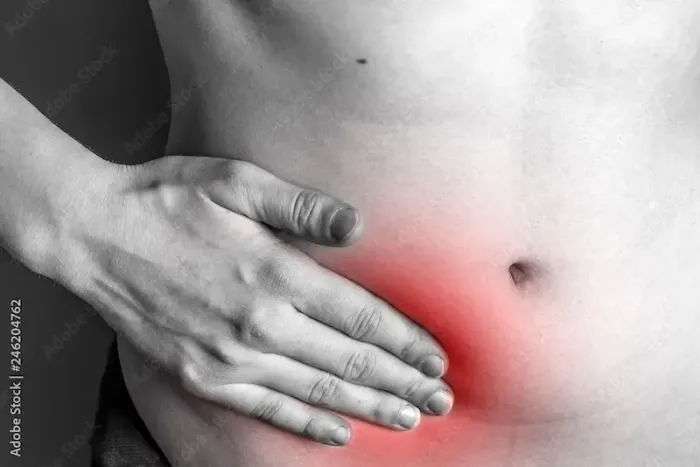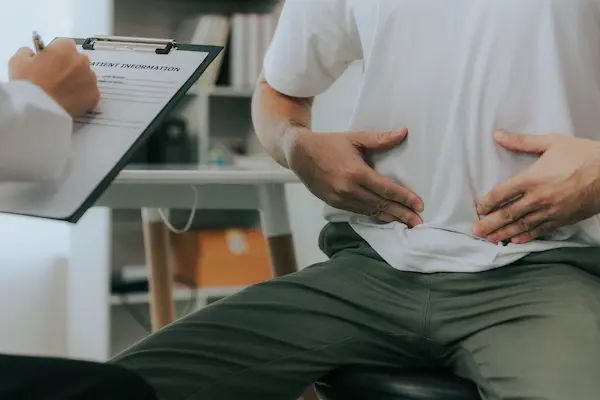Guide to Know About Hernia
Discover everything about hernias, including types, symptoms, causes, treatment options, and recovery tips. Learn how to recognise a hernia early and make informed health decisions.

Written by Dr. Md Yusuf Shareef
Reviewed by Dr. Shaik Abdul Kalam MD (Physician)
Last updated on 16th Oct, 2025

Introduction
Noticed a strange bulge in your groin or abdomen, especially when you cough or lift something heavy? You might be dealing with a hernia, a common medical condition that affects millions of people worldwide. While the word itself can sound alarming, understanding what a hernia is, how to spot one, and what your options are is the first step toward effective management and peace of mind. This comprehensive guide will walk you through everything you need to know—from the different types of hernias and their telltale symptoms to the latest surgical treatments and recovery advice. Whether you're seeking information for yourself or a loved one, our goal is to empower you with clear, actionable knowledge to navigate your health decisions confidently.
What is a Hernia? A Simple Breakdown
A hernia occurs when an organ or fatty tissue squeezes through a weak spot in a surrounding muscle or connective tissue called fascia. Think of it like an inner tube pushing through a weak spot in a tire. The most common types involve the abdominal organs, such as the intestines, pushing through a weakened area in the abdominal wall.
The Mechanics of a Hernia
The condition is primarily driven by a combination of muscle weakness and pressure. The weakness can be present at birth (congenital) or develop later in life due to age, injury, or surgery. When pressure is applied to this weakened area—from activities like heavy lifting, persistent coughing, obesity, or even straining during a bowel movement—it can force tissue or an organ through the opening, creating a visible bulge.
Consult a Specialist for the best advice
Common Types of Hernias and Their Locations
Not all hernias are the same. They are categorised based on their location, which also influences their symptoms and treatment.
Inguinal Hernia (Groin)
This is by far the most common type, accounting for about 70% of all hernias. It occurs when part of the intestine or abdominal fat protrudes through the inguinal canal in the lower abdomen. Inguinal hernias are more prevalent in men due to a natural weakness in this area related to the descent of the testicles during development.
Hiatal Hernia (Upper Stomach)
A hiatal hernia is different from others. It happens when the upper part of the stomach bulges through the diaphragm (the large muscle that separates your abdomen from your chest) into the chest cavity. This type can lead to acid reflux and heartburn, as it can interfere with the valve that keeps stomach acid from flowing back into the esophagus.
Umbilical Hernia (Belly Button)
These occur when part of the intestine pushes through the abdominal wall near the navel. Umbilical hernias are common in newborns and often close on their own by age 1 or 2. In adults, they can develop due to repeated strain on the abdomen and usually require surgical repair.
Incisional Hernia (Site of Surgery)
As the name implies, an incisional hernia can develop at the site of a previous abdominal surgery. The scar tissue is inherently weaker, making it a potential site for a hernia to form months or even years after the operation.
Femoral Hernia (Below the Groin)
More common in women, especially older women, a femoral hernia appears as a bulge in the upper thigh, just below the groin. It occurs when tissue enters the canal carrying the femoral artery into the upper leg. These hernias have a higher risk of becoming stuck (incarcerated) and require prompt medical attention.
Recognising the Signs: Hernia Symptoms
Symptoms can vary widely. Some people have no symptoms at all, while others experience significant discomfort.
Common Symptoms to Watch For
The most obvious sign is a visible bulge or lump in the affected area (abdomen, groin, or thigh). This bulge may:
• Disappear when you lie down and reappear when you stand or strain.
• Cause a dull ache or a feeling of pressure or heaviness.
• Be accompanied by pain or discomfort, especially when bending over, coughing, or lifting.
Red-Flag Symptoms: When to Seek Immediate Care
A strangulated hernia is a life-threatening complication where the blood supply to the herniated tissue is cut off. This is a medical emergency. Seek immediate care if you experience:
• Sudden, severe pain and tenderness at the bulge site.
• The bulge turning red, purple, or dark.
• Nausea, vomiting, or fever.
• Inability to pass gas or have a bowel movement.
If you experience any of these red-flag symptoms, consult a doctor online with Apollo24|7 for an immediate evaluation or go to the nearest emergency room.
Why Do Hernias Happen? Causes and Risk Factors
Understanding the causes can help in prevention and early detection.
The Role of Muscle Weakness and Strain
A hernia is the result of two factors: a pre-existing weakness and a trigger that causes strain. Weaknesses can be from a congenital condition, age-related muscle degradation, or damage from surgery or injury. The straining trigger can be:
• Chronic coughing or sneezing (e.g., from COPD or allergies).
• Heavy lifting without proper core stabilization.
• Straining during bowel movements or urination (often due to constipation or an enlarged prostate).
• Pregnancy, which increases pressure on the abdominal wall.
• Excess weight or obesity, which places constant strain on the abdomen.
Populations at Higher Risk
• Men: Significantly higher risk for inguinal hernias.
• Older Adults: Muscle weakness increases with age.
• People with a Family History: Genetics can play a role in muscle weakness.
• Smokers: Chronic coughing weakens abdominal muscles.
• Those with Chronic Constipation: Regular straining increases abdominal pressure.
Getting a Diagnosis: How Doctors Identify a Hernia
Diagnosis is typically straightforward.
The Physical Examination
In most cases, a doctor can diagnose a hernia through a physical exam. They will likely ask you to stand and cough or strain, which makes the bulge more prominent and easier to feel.
Imaging Tests for Confirmation
If the diagnosis is uncertain, or to plan for surgery, imaging tests may be ordered:
• Ultrasound: Uses sound waves to create an image of abdominal structures.
• CT Scan: Provides a detailed cross-sectional view, excellent for identifying hiatal or incisional hernias.
• Endoscopy: A camera on a thin tube is used to examine the inside of the esophagus and stomach, crucial for diagnosing a hiatal hernia.
Hernia Treatment Options: From Watchful Waiting to Surgery
The right treatment for a hernia depends on its size, symptoms, and type.
Non-Surgical Management (Watchful Waiting)
If the hernia is small and isn't causing any symptoms, your doctor may recommend a period of watchful waiting. This involves monitoring for any changes or new symptoms but not intervening immediately.
Hernia Trusses and Supports
A truss is a supportive undergarment that can hold a hernia in place. It may provide temporary relief for some, but it is not a cure and should only be used under a doctor's guidance, as improper use can cause more harm.
Surgical Repair: Herniorrhaphy and Hernioplasty
Surgery is the only way to permanently repair a hernia. The two main approaches are:
Open Hernia Repair Surgery
In this traditional method, the surgeon makes a single larger incision near the site, pushes the protruding tissue back into place, and then repairs the weakened muscle wall. Often, a synthetic mesh (mesh repair) is sewn in to reinforce the area and significantly reduce the risk of recurrence.
Laparoscopic Hernia Surgery
This is a minimally invasive technique. The surgeon makes several small incisions and uses a laparoscope (a tiny camera) and specialised instruments to perform the repair from behind the abdominal wall using mesh. Benefits often include less post-operative pain, smaller scars, and a faster recovery time from hernia surgery.
The Road to Recovery: What to Expect After Hernia Surgery
Recovery varies by the type of surgery and the individual.
Immediate Post-Op Care
You can usually go home the same day. You'll be advised to manage pain with medication, keep the incision site clean and dry, and rest. Light walking is encouraged to promote blood flow and prevent blood clots.
Long-Term Healing and Activity Guidelines
While you may feel better in a week or two, full healing takes longer. Most people can return to light activities within two weeks but must avoid heavy lifting (anything over 10-15 pounds) and strenuous exercise for 4 to 6 weeks. Your surgeon will provide specific guidelines based on your job and activity level.
Can You Prevent a Hernia? Proactive Measures
You can't always prevent a hernia, especially those caused by congenital weaknesses, but you can reduce your risk.
Lifestyle and Dietary Changes
• Maintain a healthy weight to reduce pressure on your abdomen.
• Eat a high-fiber diet (fruits, vegetables, whole grains) to prevent constipation and straining.
• Avoid smoking to prevent the chronic cough that weakens muscles.
Proper Lifting Techniques and Core Strengthening
• Lift Properly: Always lift with your legs, not your back. Keep your back straight and bend your knees. Avoid lifting weights that are too heavy for you.
• Strengthen Your Core: Exercises that strengthen your abdominal and core muscles (like planks and pelvic tilts) can provide better support. However, avoid sit-ups or crunches if you are at high risk, as they can increase intra-abdominal pressure.
Conclusion
Living with a hernia can be a source of anxiety and discomfort, but it's a highly manageable condition. From understanding the initial symptoms of a hernia to evaluating surgical treatment options, being informed empowers you to have productive conversations with your healthcare provider. Remember, while watchful waiting is an option for some, a proactive approach to treatment is often the best path to preventing complications and returning to a pain-free life. If you suspect you have a hernia or have been diagnosed and want to discuss your options, don't hesitate to seek professional guidance. You can consult with a experienced general surgeon online via Apollo24|7 to get personalised advice and a clear treatment plan tailored to your specific needs.
Consult a Specialist for the best advice
Consult a Specialist for the best advice

Dr. Mainak Baksi
General Practitioner
13 Years • MBBS , MD (MPH)
Howrah
Mainak Baksi Clinic, Howrah
(50+ Patients)

Dr. Dhankecha Mayank
General Practitioner
6 Years • MBBS
Hyderabad
Apollo 24|7 Clinic - Telangana, Hyderabad

Dr. Rajib Ghose
General Physician/ Internal Medicine Specialist
25 Years • MBBS
East Midnapore
VIVEKANANDA SEBA SADAN, East Midnapore

Dr. Vasanthasree Nair
General Practitioner
15 Years • MBBS
Angamaly
Apollo 24|7 Clinic - Kerala, Angamaly
(500+ Patients)

Dr. Suvadeep Sen
Critical Care Specialist
12 Years • MBBS, MD, FNB (CRITICAL CARE MEDICINE), EDIC
Mumbai
Apollo Hospitals CBD Belapur, Mumbai
Consult a Specialist for the best advice

Dr. Mainak Baksi
General Practitioner
13 Years • MBBS , MD (MPH)
Howrah
Mainak Baksi Clinic, Howrah
(50+ Patients)

Dr. Dhankecha Mayank
General Practitioner
6 Years • MBBS
Hyderabad
Apollo 24|7 Clinic - Telangana, Hyderabad

Dr. Rajib Ghose
General Physician/ Internal Medicine Specialist
25 Years • MBBS
East Midnapore
VIVEKANANDA SEBA SADAN, East Midnapore

Dr. Vasanthasree Nair
General Practitioner
15 Years • MBBS
Angamaly
Apollo 24|7 Clinic - Kerala, Angamaly
(500+ Patients)

Dr. Suvadeep Sen
Critical Care Specialist
12 Years • MBBS, MD, FNB (CRITICAL CARE MEDICINE), EDIC
Mumbai
Apollo Hospitals CBD Belapur, Mumbai
More articles from Hernia
Frequently Asked Questions
1. Can a hernia heal on its own?
No, hernias cannot heal on their own. The opening in the muscle wall will not close without surgical intervention. However, small, asymptomatic hernias may not require immediate surgery and can be monitored.
2. What happens if a hernia is left untreated?
While many small hernias cause no problems, there is always a risk of the hernia becoming incarcerated (stuck) or strangulated (blood supply cut off). A strangulated hernia is a surgical emergency and can be life-threatening.
3. Is hernia surgery safe? What about the mesh?
Modern hernia surgery is very safe and effective. The use of surgical mesh has dramatically reduced recurrence rates. While there have been concerns about certain types of mesh in the past, today's meshes are extensively tested and considered safe for the vast majority of patients. Discuss any concerns with your surgeon.
4. How long does it take to recover from laparoscopic hernia surgery?
Most people can return to desk work and light activities within a week. Full recovery, including the ability to resume heavy lifting and strenuous exercise, typically takes 4-6 weeks.
5. Can a hernia come back after surgery?
Yes, there is a chance of recurrence, but it is relatively low, especially when mesh is used to reinforce the repair. Recurrence rates are typically between 1-5% for mesh repairs but can be higher for complex or large hernias.




